A Capacitance-to-Time Converter-Based Electronic Interface for Differential Capacitive Sensors
Abstract
1. Introduction
2. Materials and Methods
3. Results
3.1. Simulations
3.2. Preliminary Experimental Measurements
3.3. Relative Humidity (RH) Sensor
3.4. Liquid Level
4. Discussion
5. Conclusions
Author Contributions
Funding
Acknowledgments
Conflicts of Interest
References
- Yuan, J.S.; Bi, Y. Process and temperature robust voltage multiplier design for RF energy harvesting. Micorelectron. Reliab. 2015, 55, 107–113. [Google Scholar] [CrossRef]
- Bi, Y.; Gaillardon, P.E.; Hu, X.S.; Niemier, M.; Yuan, J.S.; Jin, Y. Leveraging Emerging Technology for Hardware Security—Case Study on Silicon Nanowire FETs and Graphene SymFETs. In Proceedings of the 2014 IEEE 23rd Asian Test Symposium, Hangzhou, China, 16–19 November 2014; pp. 342–347. [Google Scholar] [CrossRef]
- Bi, Y.; Shamsi, K.; Yuan, J.S.; Jin, Y.; Niemier, M.; Hu, X.S. Tunnel FET Current Mode Logic for DPA-Resilient Circuit Designs. IEEE Trans. Emerg. Top. Comput. 2017, 5, 340–352. [Google Scholar] [CrossRef]
- Chen, X.; Brox, D.; Assadsangabi, B.; Ali, M.S.M.; Takahata, K. A stainless-steel-based implantable pressure sensor chip and its integration by microwelding. Sens. Actuators A Phys. 2017, 257, 134–144. [Google Scholar] [CrossRef]
- Apigo, D.J.; Bartholomew, P.L.; Russell, T.; Kanwal, A.; Farrow, R.C.; Thomas, G.A. An Angstrom-sensitive, differential MEMS capacitor for monitoring the milliliter dynamics of fluids. Sens. Actuators A Phys. 2016, 251, 234–240. [Google Scholar] [CrossRef] [PubMed]
- Rivadeneyra, A.; Fernández-Salmerón, J.; Agudo-Acemel, M.; López-Villanueva, J.A.; Capitan-Vallvey, L.F.; Palma, A.J. Printed electrodes structures as capacitive humidity sensors: A comparison. Sens. Actuators A Phys. 2016, 244, 56–65. [Google Scholar] [CrossRef]
- Aydemir, A.; Terzioglu, Y.; Akin, T. A new design and a fabrication approach to realize a high performance three axes capacitive MEMS accelerometer. Sens. Actuators A Phys. 2016, 244, 324–333. [Google Scholar] [CrossRef]
- Rahman, M.D.T.; Rahimi, A.; Gupta, S.; Panat, R. Microscale additive manufacturing and modeling of interdigitated capacitive touch sensors. Sens. Actuators A Phys. 2016, 246, 94–103. [Google Scholar] [CrossRef]
- Liu, Y.T.; Kuo, Y.L.; Yan, D.W. System integration for on-machine measurement using a capacitive LVDT-like contact sensor. Adv. Manuf. 2017, 5, 50–58. [Google Scholar] [CrossRef]
- Bai, Y.; Lu, Y.; Hu, P.; Wang, G.; Xu, J.; Zeng, T.; Li, Z.; Zhang, Z.; Tan, J. Absolute position sensing based on a robust differential capacitive sensor with a grounded shield window. Sensors 2016, 16, 680. [Google Scholar] [CrossRef]
- Park, S.H.; Kim, H.S.; Bang, J.S.; Cho, G.H.; Cho, G.H. A 0.26-nJ/node, 400-kHz Tx driving, filtered fully differential readout IC with parasitic RC time delay reduction technique for 65-in 169 × 97 capacitive-type touch screen panel. IEEE J. Solid-State Circuits 2017, 52, 528–542. [Google Scholar] [CrossRef]
- Liu, X.; Peng, K.; Chen, Z.; Pu, H.; Yu, Z. A new capacitive displacement sensor with nanometer accuracy and long range. IEEE Sens. J. 2016, 16, 2306–2316. [Google Scholar] [CrossRef]
- Ciccarella, P.; Carminati, M.; Sampietro, M.; Ferrari, M. Multichannel 65zF RMS resolution CMOS monolithic capacitive sensor for counting single micrometer-sized airborne particles on chip. IEEE J. Solid-State Circuits 2016, 51, 2545–2553. [Google Scholar] [CrossRef]
- Wu, X.; Deng, F.; Hao, Y.; Fu, Z.; Zhang, L. Design of a humidity sensor tag for passive wireless applications. Sensors 2015, 15, 25564–25576. [Google Scholar] [CrossRef] [PubMed]
- Arefin, M.S.; Redouté, J.M.; Yuce, M.R. A MEMS interface IC with low-power and wide-range frequency-to-voltage converter for biomedical applications. IEEE Trans. Biomed. Circuits Syst. 2016, 10, 455–466. [Google Scholar] [CrossRef] [PubMed]
- Constandinou, T.G.; Georgiou, J.; Toumazou, C. A micropower front-end interface for differential-capacitive sensor systems. In Proceedings of the 2008 IEEE International Symposium on Circuits and Systems, Seattle, WA, USA, 18–21 May 2008; pp. 2474–2477. [Google Scholar] [CrossRef]
- Mochizuki, K.; Watanabe, K.; Masuda, K. A high-accuracy high-speed signal processing circuit of differential-capacitance transducers. IEEE Trans. Instrum. Meas. 1998, 47, 1244–1247. [Google Scholar] [CrossRef]
- Singh, T.; Saether, T.; Ytterdal, T. Current-mode capacitive sensor interface circuit with single-ended to differential output capability. IEEE Trans. Instrum. Meas. 2009, 58, 3914–3920. [Google Scholar] [CrossRef]
- Royo, G.; Sánchez-Azqueta, C.; Gimeno, C.; Aldea, C.; Celma, S. Programmable low-power low-noise capacitance to voltage converter for MEMS accelerometers. Sensors 2017, 17, 67. [Google Scholar] [CrossRef] [PubMed]
- Scotti, G.; Pennisi, S.; Monsurro, P.; Trifiletti, A. 88-μA 1-MHz stray-insensitive CMOS current-mode interface IC for differential capacitive sensors. IEEE Trans. Circuits Syst. 2014, 61, 1905–1916. [Google Scholar] [CrossRef]
- Kyriakis-Bitzaros, E.D.; Stathopoulos, N.A.; Pavlos, S.; Goustouridis, D.; Chatzandroulis, S. A reconfigurable multichannel capacitive sensor array interface. IEEE Trans. Instrum. Meas. 2011, 60, 3214–3221. [Google Scholar] [CrossRef]
- Wang, S.; Koickal, T.J.; Hamilton, A.; Mastropaolo, E.; Cheung, R.; Abel, A.; Smith, L.S.; Wang, L. A power-efficient capacitive read-out circuit with parasitic-cancellation for MEMS cochlea sensors. IEEE Trans. Biomed. Circuits Syst. 2016, 10, 25–37. [Google Scholar] [CrossRef]
- Ignjatovic, Z.; Bocko, M.F. An interface circuit for measuring capacitance changes based upon capacitance-to-duty cycle (CDC) converter. IEEE Sens. J. 2005, 5, 403–410. [Google Scholar] [CrossRef]
- De Marcellis, A.; Ferri, G.; Mantenuto, P. A CCII-based non-inverting Schmitt trigger and its application as astable multivibrator for capacitive sensor interfacing. Int. J. Circuit Theory Appl. 2016, 45, 1060–1076. [Google Scholar] [CrossRef]
- Bruschi, P.; Nizza, N.; Piotto, M. A current-mode, dual slope, integrated capacitance-to-pulse duration converter. IEEE J. Solid-State Circuits 2007, 42, 1884–1891. [Google Scholar] [CrossRef]
- Tan, Z.; Shalmany, S.H.; Meijer, G.C.M.; Pertijs, M.A.P. An energy-efficient 15-bit capacitive-sensor interface based on period modulation. IEEE J. Solid-State Circuits 2012, 47, 1703–1711. [Google Scholar] [CrossRef]
- He, Y.; Chang, Z.Y.; Pakula, L.; Shalmany, S.H.; Pertijs, M.A.P. A 0.05 mm2 1 V capacitance-to-digital converter based on period modulation. In Proceedings of the IEEE International Solid-State Circuits Conference (ISSCC), San Francisco, CA, USA, 22–26 February 2015; pp. 1–3. [Google Scholar] [CrossRef]
- Nizza, N.; Dei, M.; Butti, F.; Bruschi, P. A low-power interface for capacitive sensors with PWM output and intrinsic low pass characteristic. IEEE Trans. Circuits Syst. 2013, 60, 1419–1431. [Google Scholar] [CrossRef]
- Lu, J.H.L.; Inerowicz, M.; Joo, S.; Kwon, J.K.; Jung, B. A low-power wide-dynamic-range semi-digital universal sensor readout circuit using pulsewidth modulation. IEEE Sens. J. 2011, 11, 1134–1144. [Google Scholar] [CrossRef]
- Sheu, M.L.; Hsu, W.H.; Tsao, L.J. A capacitance-ratio-modulated current front-end circuit with pulsewidth modulation output for a capacitive sensor interface. IEEE Trans. Instrum. Meas. 2012, 61, 447–455. [Google Scholar] [CrossRef]
- Arefin, M.S.; Redouté, J.M.; Yuce, M.R. A low-power and wide-range MEMS capacitive sensors interface IC using pulse-width modulation for biomedical applications. IEEE Sens. J. 2016, 16, 6745–6754. [Google Scholar] [CrossRef]
- Brookhuis, R.A.; Lammerink, T.S.J.; Wiegerink, R.J. Differential capacitive sensing circuit for a multi-electrode capacitive force sensor. Sens. Actuators A Phys. 2015, 234, 168–179. [Google Scholar] [CrossRef]
- Aezinia, F.; Bahreyni, B. Low-power parasitic-insensitive interface circuit for capacitive microsensors. IET Circuits Device Syst. 2016, 10, 104–110. [Google Scholar] [CrossRef]
- De Marcellis, A.; Cubells-Beltrán, M.D.; Reig, C.; Madrenas, J.; Zadov, B.; Paperno, E.; Cardoso, S.; Freitas, P.P. Quasi-digital front-ends for current measurement in integrated circuits with GMR technology. IET Circuits Device Syst. 2014, 8, 291–300. [Google Scholar] [CrossRef]
- Mohan, N.M.; Shet, A.R.; Kedarnath, S.; Kumar, V.J. Digital converter for differential capacitive sensors. IEEE Trans. Instrum. Meas. 2008, 57, 2576–2581. [Google Scholar] [CrossRef]
- Reverter, F.; Casas, O. Interfacing differential capacitive sensors to microcontrollers: A direct approach. IEEE Trans. Instrum. Meas. 2010, 59, 2763–2769. [Google Scholar] [CrossRef]
- Nabovati, G.; Ghafar-Zadeh, E.; Mirzaei, M.; Ayala-Charca, G.; Awwad, F.; Sawan, M. A new fully differential CMOS capacitance to digital converter for lab-on-chip applications. IEEE Trans. Biomed. Circuits Syst. 2015, 9, 353–361. [Google Scholar] [CrossRef] [PubMed]
- Omran, H.; Arsalan, M.; Salama, K.N. An integrated energy-efficient capacitive sensor digital interface circuit. Sens. Actuators A Phys. 2014, 216, 43–51. [Google Scholar] [CrossRef]
- Shin, D.Y.; Lee, H.; Kim, S. A delta–sigma interface circuit for capacitive sensors with an automatically calibrated zero point. IEEE Trans. Circuits Syst. II Express Briefs 2011, 58, 90–94. [Google Scholar] [CrossRef]
- Alhoshany, A.; Omran, H.; Salama, K.N. A 45.8 fJ/step, energy-efficient, differential SAR capacitance-to-digital converter for capacitive pressure sensing. Sens. Actuators A Phys. 2016, 245, 10–18. [Google Scholar] [CrossRef]
- Tan, Z.; Daamen, R.; Humbert, A.; Ponomarev, Y.V.; Chae, Y.; Pertijs, M.A.P. A 1.2-V 8.3-nJ CMOS humidity sensor for RFID applications. IEEE J. Solid-State Circuits 2013, 48, 2469–2477. [Google Scholar] [CrossRef]
- Oh, S.; Lee, Y.; Wang, J.; Foo, Z.; Kim, Y.; Blaauw, D. Dual-slope capacitance to digital converter integrated in an implantable pressure sensing system. In Proceedings of the 40th European Solid State Circuits Conference (ESSCIRC), Venice, Italy, 22–26 September 2014; pp. 295–298. [Google Scholar] [CrossRef]
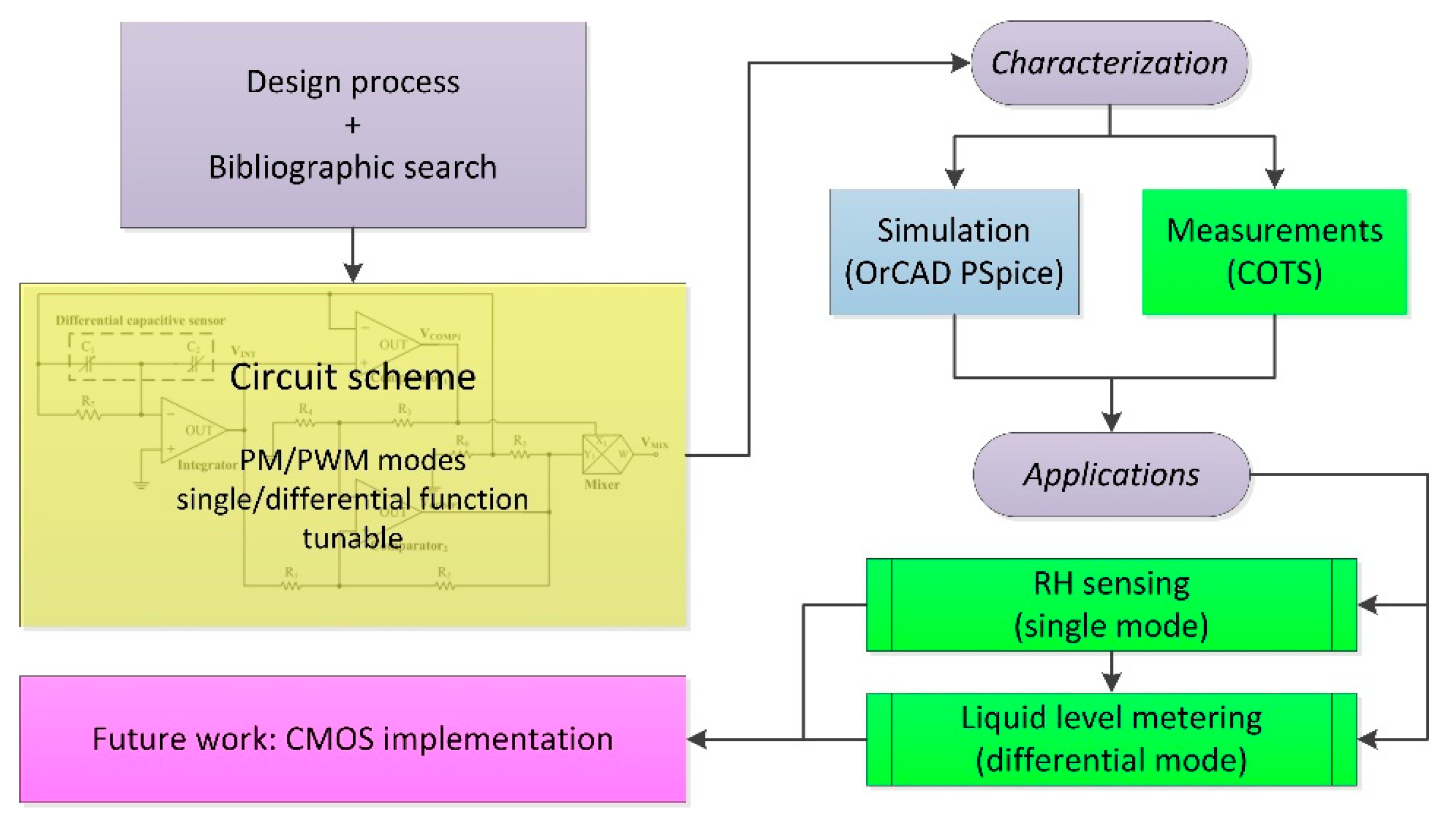
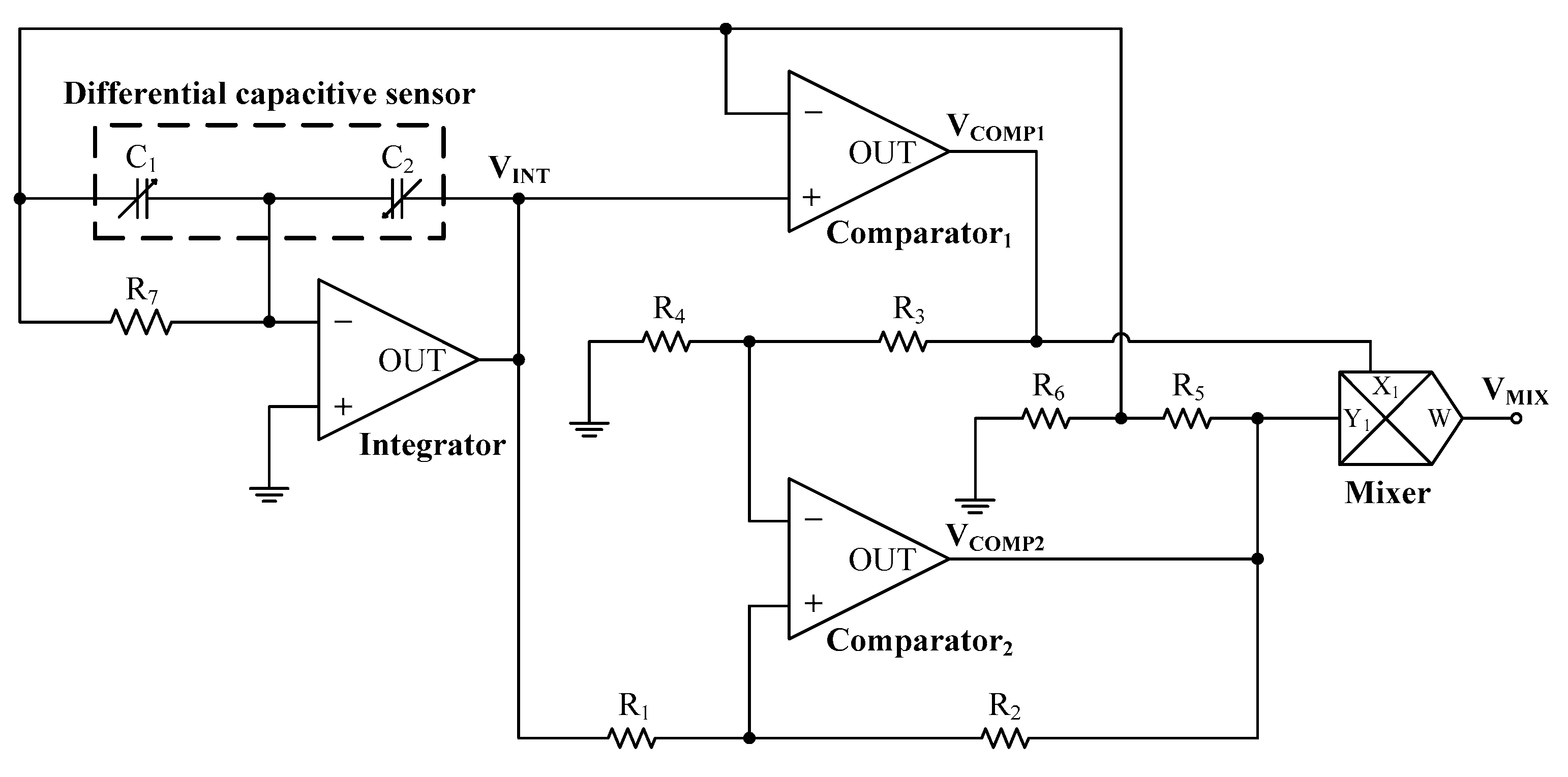

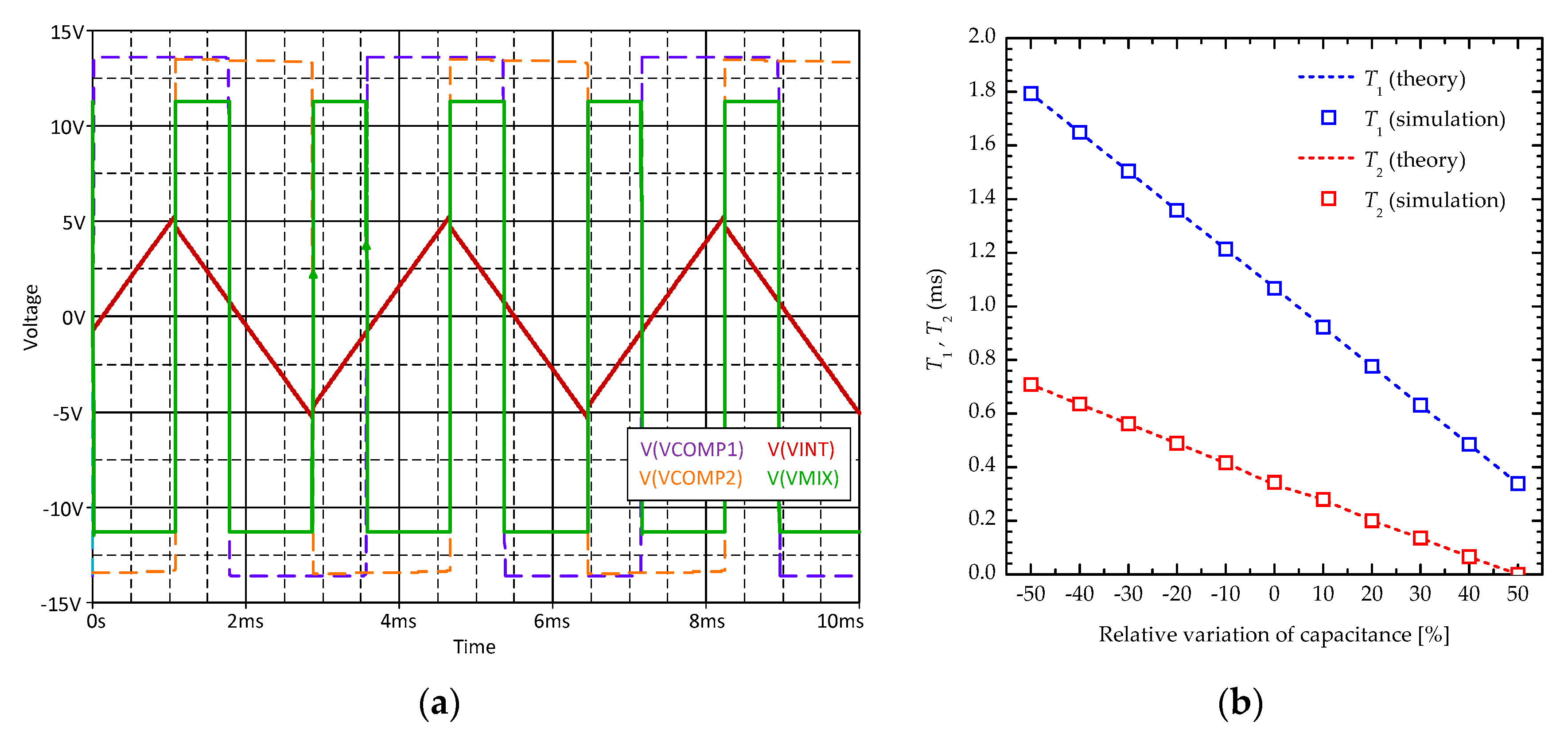
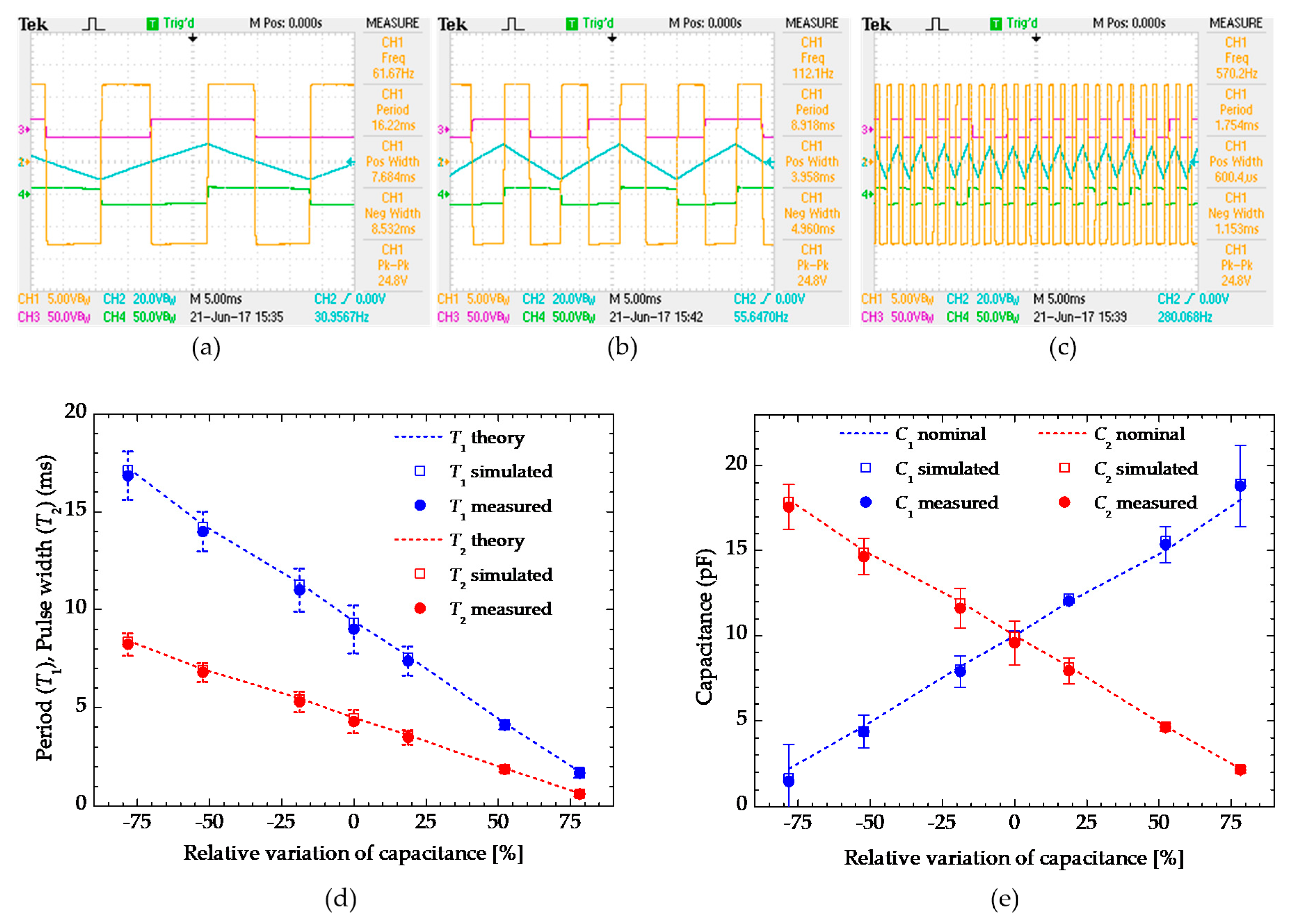
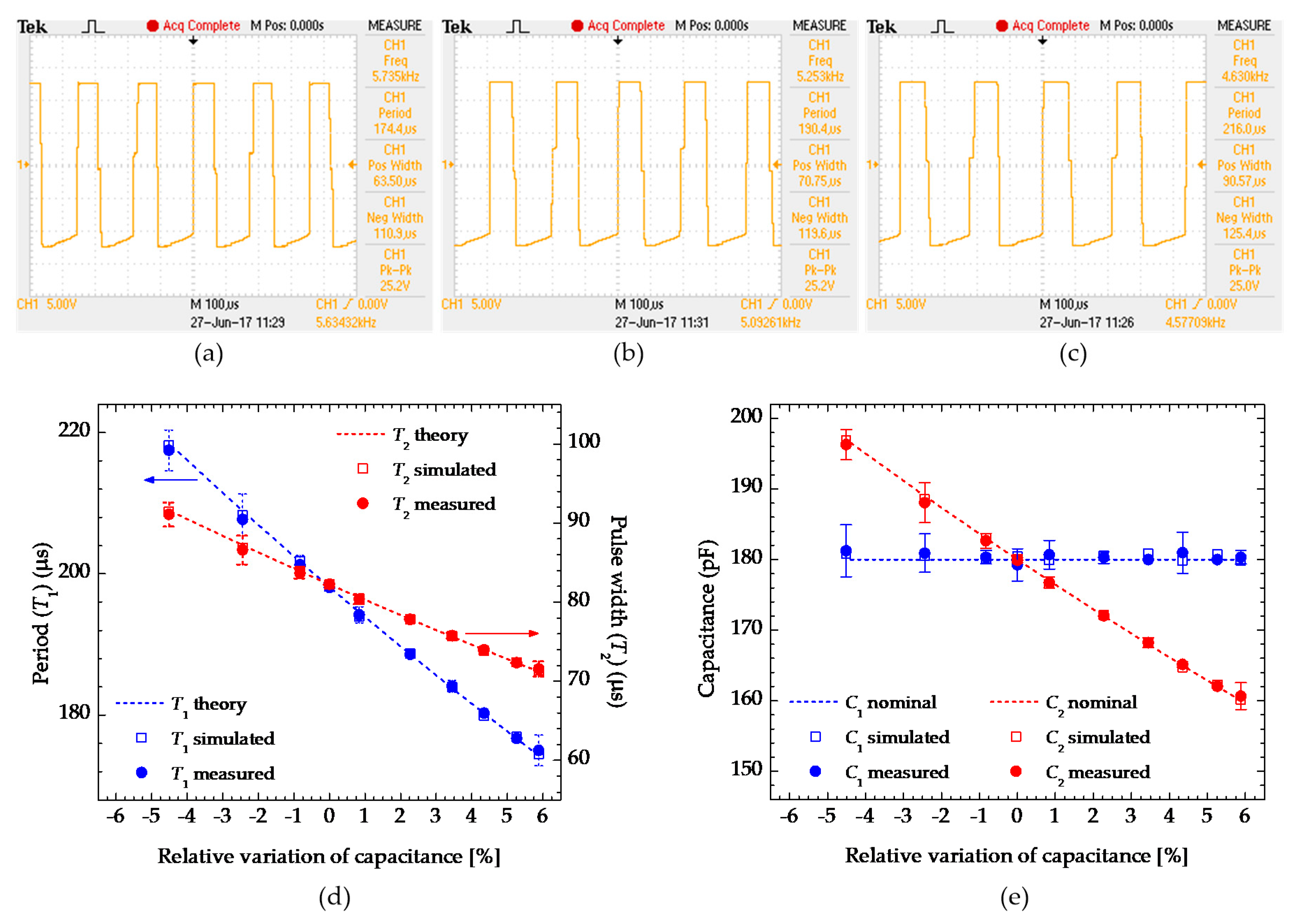
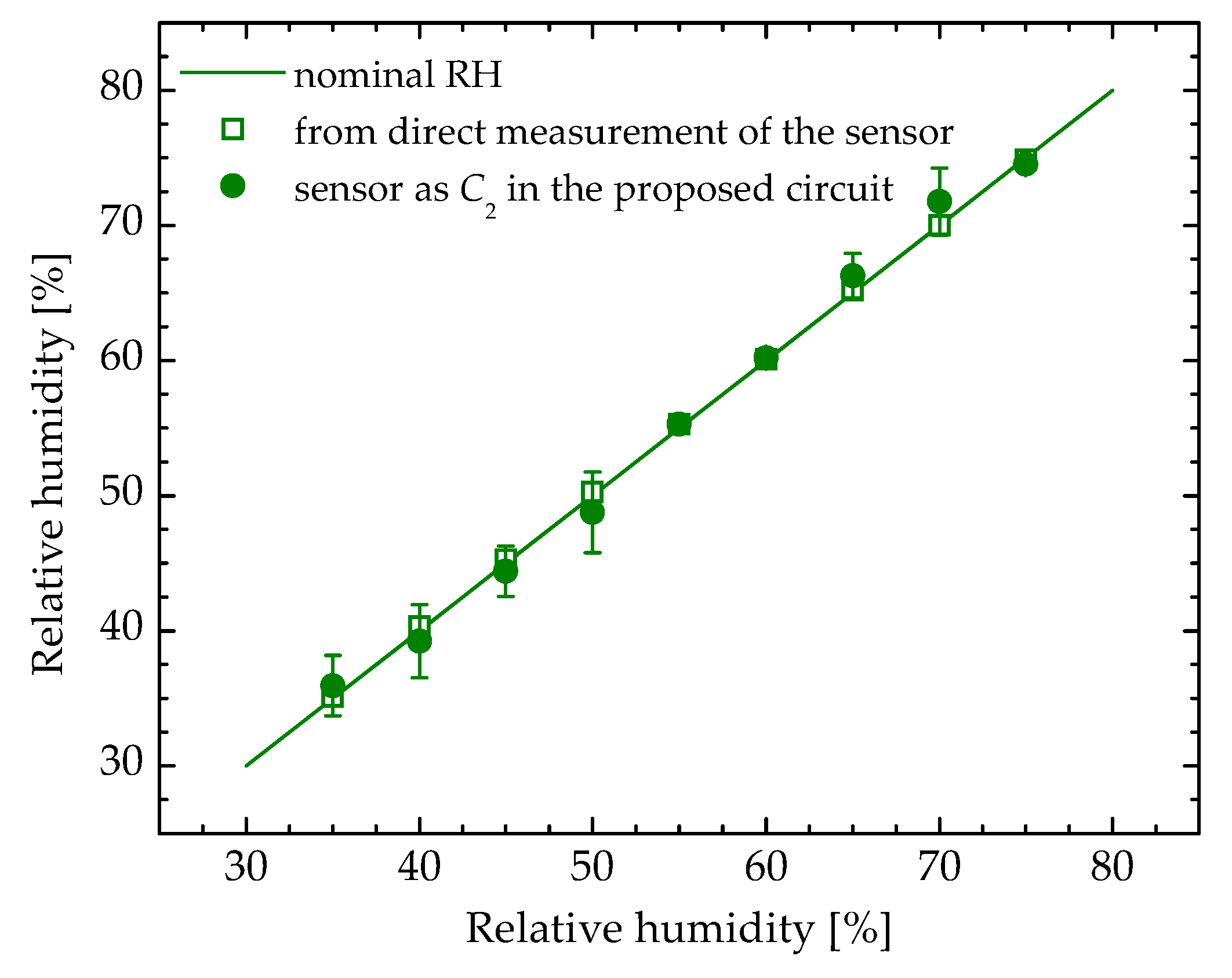
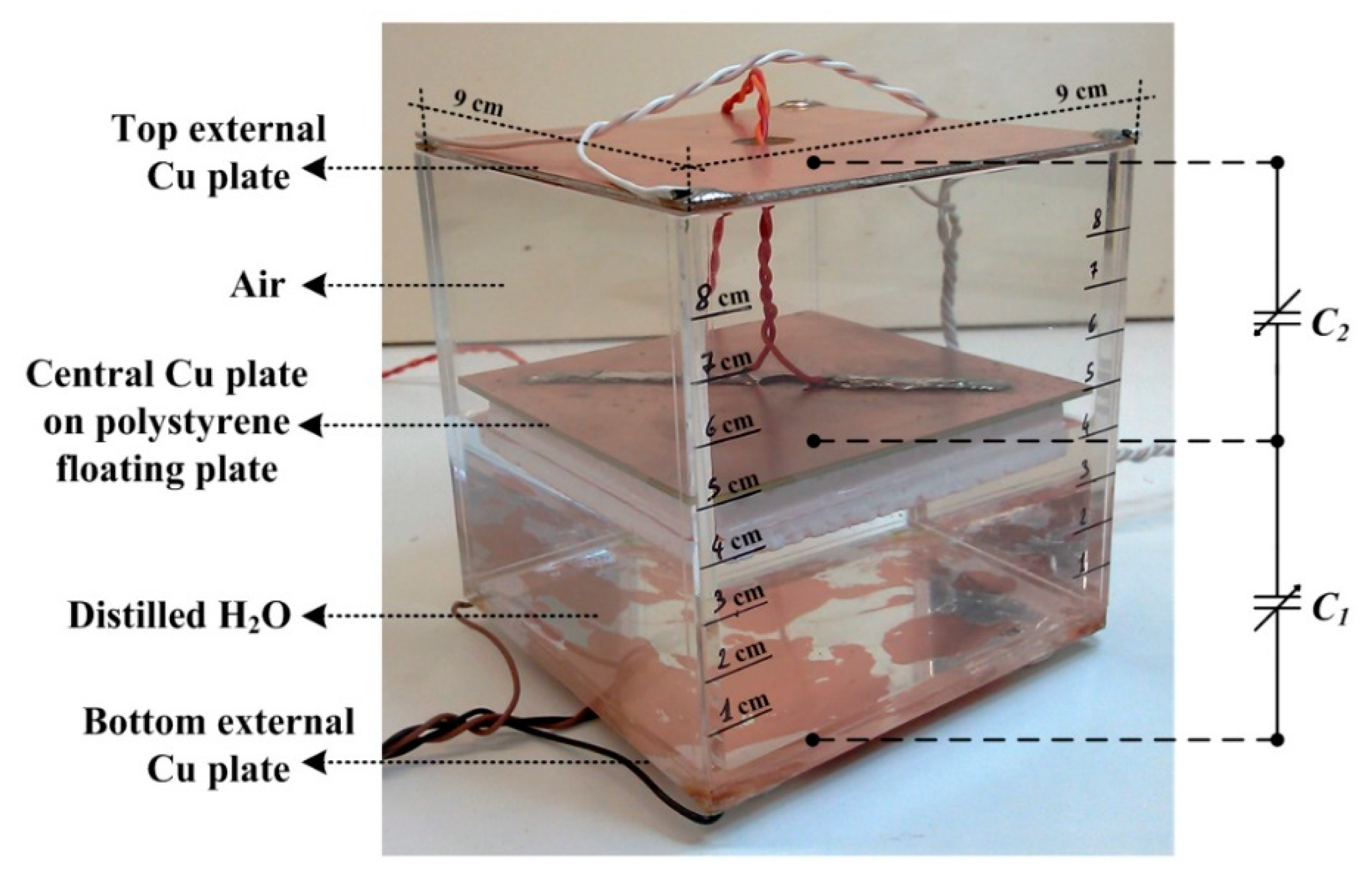
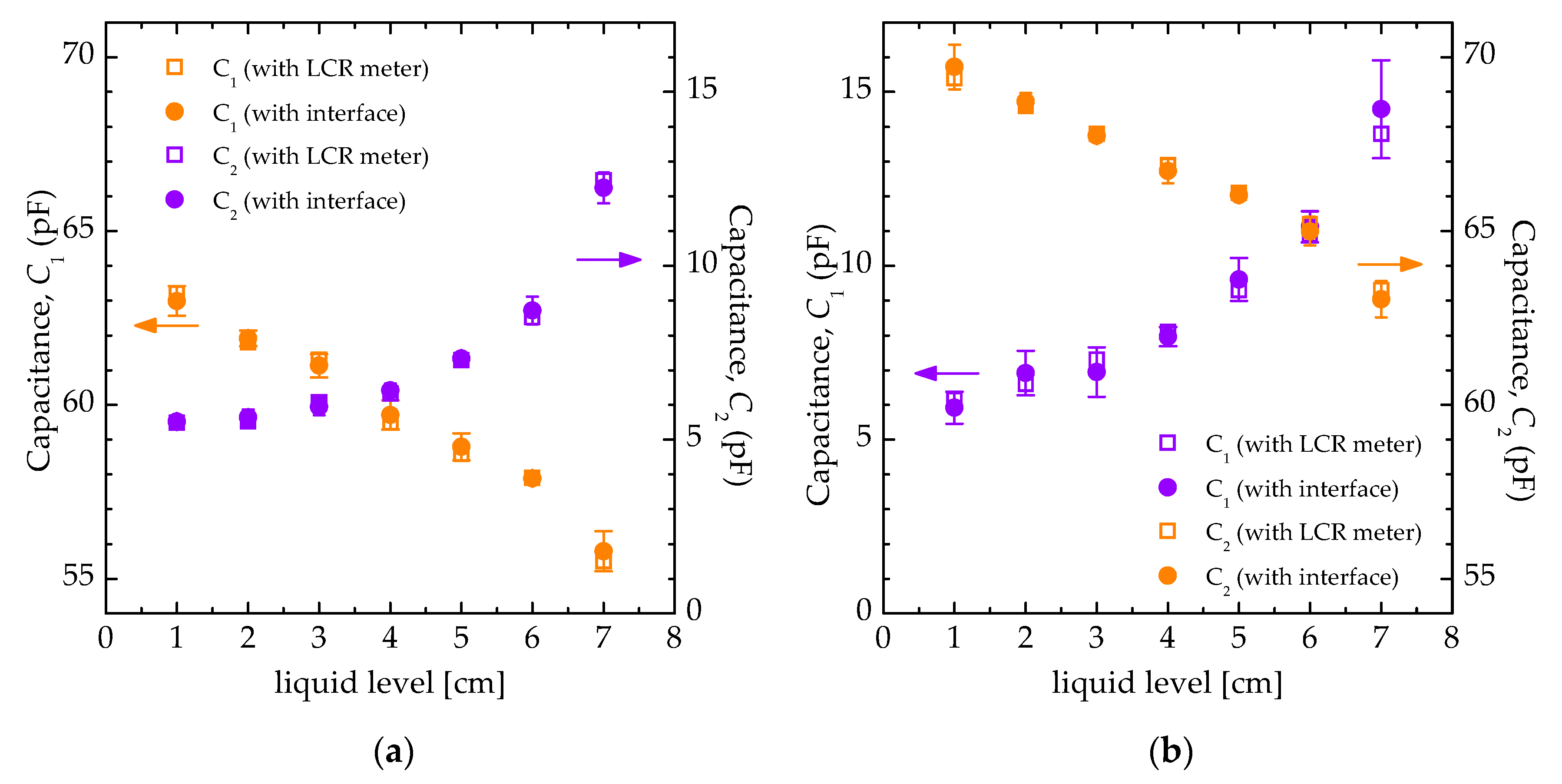
| Ref. | Sensor Topology | Circuit Typology | Circuit Realization | Output Format | Detection Range | Sensitivity | Resolution |
|---|---|---|---|---|---|---|---|
| [25] | Single element | A/D mixed signal | On chip integration | PWM | 0.8–1.2 pF | 47 μs/pF @ 20 kHz 15 μs/pF @ 50 kHz | 0.9 fF |
| [26] | Single element | A/D mixed signal | On chip integration | PM | 1.8–6.8 pF | 1.12 ms/pF | 0.2 fF |
| [27] | Single element | A/D mixed signal | On chip integration | PM | 0–8 pF | n.a. | 1.4 fF |
| [28] | Single element | Analogue | On chip integration | PWM | 16–256 fF | 32 μs/pF | 0.8 fF |
| [29] | Single element | Analogue | On chip integration | PWM | 0.013 fF–9 pF | 1.82 μs/pF | 0.013 fF |
| [30] | Single element | Analogue | On chip integration | PWM | 2.5–2.8255 pF | 3.88 μs/pF | 2.8 fF |
| [31] | Single element | Analogue | On chip integration | PWM | 1–22 pF | 3.62 μs/pF | 0.011 fF |
| [32] | Differential element | Analogue | Discrete components | PM | 0–19.8 pF (single) −19.8 ÷ +19.8 pF (differential) | 0.49 μs/pF (differential) | 2 fF (differential) |
| [33] | Differential element | A/D mixed signal | On chip integration | PWM | 40–60 fF (single) −20 ÷ +20 fF (differential) | 127 μs/pF (differential) | 0.16 fF (differential) |
| [35] | Differential element | A/D mixed signal | Discrete components | PM | 400 pF (±50%) | n.a. | 10 pF |
| This work | Single or Differential element | Analogue | Discrete components | PWM PM | 2.2–197 pF (single) [−15.8 ÷ +15.8 pF] (differential) | 1 μs/pF (single) 982 μs/pF (differential) | 83 fF (single) 0.1 fF (differential) |
© 2019 by the authors. Licensee MDPI, Basel, Switzerland. This article is an open access article distributed under the terms and conditions of the Creative Commons Attribution (CC BY) license (http://creativecommons.org/licenses/by/4.0/).
Share and Cite
De Marcellis, A.; Reig, C.; Cubells-Beltrán, M.-D. A Capacitance-to-Time Converter-Based Electronic Interface for Differential Capacitive Sensors. Electronics 2019, 8, 80. https://doi.org/10.3390/electronics8010080
De Marcellis A, Reig C, Cubells-Beltrán M-D. A Capacitance-to-Time Converter-Based Electronic Interface for Differential Capacitive Sensors. Electronics. 2019; 8(1):80. https://doi.org/10.3390/electronics8010080
Chicago/Turabian StyleDe Marcellis, Andrea, Càndid Reig, and María-Dolores Cubells-Beltrán. 2019. "A Capacitance-to-Time Converter-Based Electronic Interface for Differential Capacitive Sensors" Electronics 8, no. 1: 80. https://doi.org/10.3390/electronics8010080
APA StyleDe Marcellis, A., Reig, C., & Cubells-Beltrán, M.-D. (2019). A Capacitance-to-Time Converter-Based Electronic Interface for Differential Capacitive Sensors. Electronics, 8(1), 80. https://doi.org/10.3390/electronics8010080







